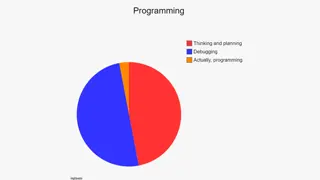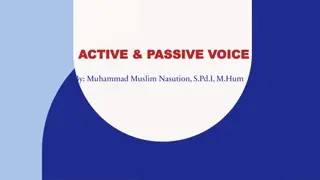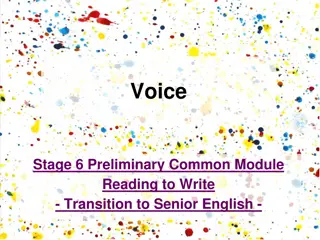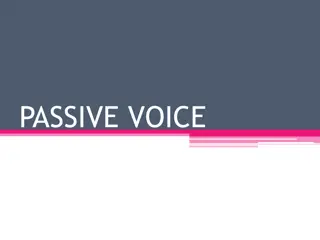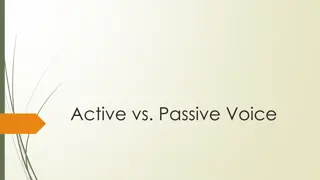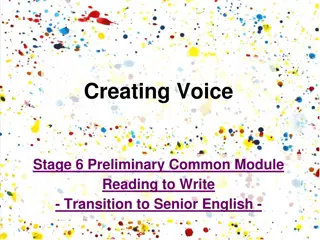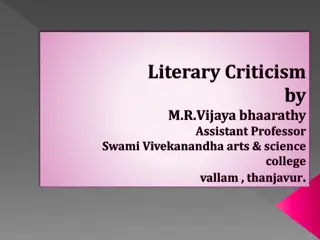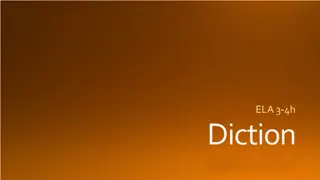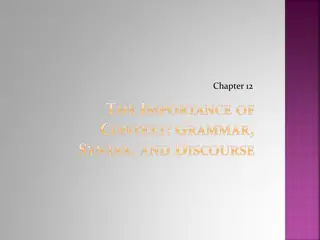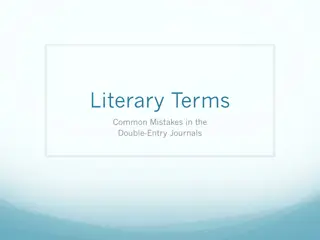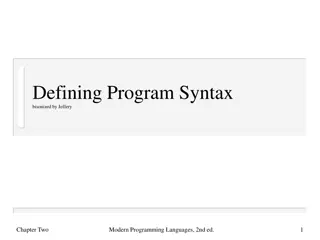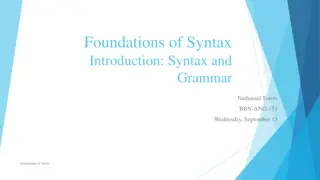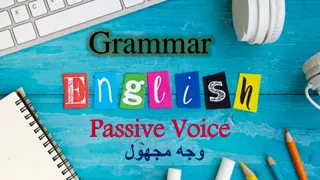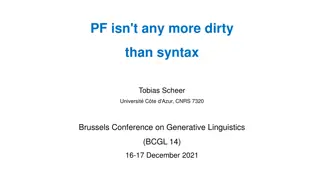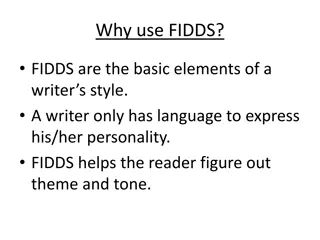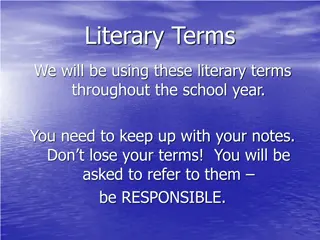Literary Analysis: Imagery, Syntax, Diction, and Detail in Voice Lessons
Explore the use of auditory and olfactory imagery in Kate Chopin's "The Awakening," analyze the syntactic structure in Edgar Allan Poe's "The Black Cat," understand the nuances of diction, and delve into Winston Churchill's portrayal of King Henry VIII through contrasting details. Engage with questions on auditory and olfactory imagery, appositives and sentence structure, the impact of adverbs on diction, and the portrayal of multidimensional personalities in literature.
Download Presentation

Please find below an Image/Link to download the presentation.
The content on the website is provided AS IS for your information and personal use only. It may not be sold, licensed, or shared on other websites without obtaining consent from the author.If you encounter any issues during the download, it is possible that the publisher has removed the file from their server.
You are allowed to download the files provided on this website for personal or commercial use, subject to the condition that they are used lawfully. All files are the property of their respective owners.
The content on the website is provided AS IS for your information and personal use only. It may not be sold, licensed, or shared on other websites without obtaining consent from the author.
E N D
Presentation Transcript
Voice lessons: Imagery Practice #3 She looked into the distance, and the old terror flamed up for an instant, then sank again. Edna heard her father s voice and her sister Margaret s. She heard the barking of an old dog that was chained to the sycamore tree. The spurs of the cavalry officer clanged as he walked across the porch. There was the hum of bees, and the musky odor of pinks filled the air. - Kate Chopin, The Awakening 1. Although the narrator looks into the distance, the images are primarily auditory. What are the auditory images in the passage? What mood do these images create? 2. The last sentence of this passage contains an olfactory image (the musky odor of pinks fill the air). What effect does the use of an olfactory image, after a series of auditory images, have on the reader? 3. Write a paragraph in which you create a scene through auditory imagery. The purpose of your paragraph is to create a calm, peaceful mood. Use one olfactory image to enhance the mood created by auditory imagery.
Voice lessons: Syntax Practice #3 No sooner had the reverberation of my blows sunk into silence, then I was answered by a voice from within the tomb! by a cry, at first muffled and broken, like the sobbing of a child, and then quickly swelling into one long, loud, and continuous scream, utterly anomalous and inhuman a howl! a wailing shriek, half of horror and half of triumph, such as might have arisen only out of hell, conjointly from the throats of the damned in their agony and of the demons that exult in the damnation. - Edgar Allan Poe, The Black Cat 1. The dashes in this long sentence set off a series of appositives. (An appositive is a noun or noun phrase placed beside another noun or noun phrase and used to identify or explain it.) What noun phrase is explained by the appositives? 2. This sentence makes syntactic and semantic sense if it ends with the first exclamation point. What do the appositives add to the meaning and effectiveness of the sentence? 3. Rewrite Poe s sentence, changing it into a series of short sentences. Discuss how the use of short sentences changes the overall meaning of the
Voice lessons: Diction Practice #4 The man sighed hugely. 1. What does it mean to sigh hugely? 2. How would the meaning of the sentence change if we rewrote it as the following: The man sighed loudly. 3. Fill in the blank with an adverb: The man coughed ______________. Your adverb should make the cough express an attitude. For example, the cough could express contempt, desperation, or propriety. Do not state the attitude.
Voice lessons: detail Practice #4 To those who saw him often he seemed almost like two men: one the merry monarch of the hunt and banquet and procession, the friend of children, the patron of every kind of sport; the other the cold, acute observer of the audience chamber or the Council, watching vigilantly, weighing arguments, refusing except under the stress of great events to speak his own mind. - Winston Churchill, King Henry VIII, Churchill s History of the English- Speaking Peoples 1. Churchill draws attention of the contrasting sides of Henry VIII through detail. How is the impact of this sentence strengthened by the order of the details presentation? 2. What is Churchill s attitude toward Henry? What specific details reveal this attitude? 3. Think of someone you know who has two strong sides to his/her personality. Using Churchill s sentence as a model, write a sentence which captures, through detail, these two sides.
Voice lessons: Tone practice #4 Microphone feedback kept blaring out the speaker s words, but I got the outline. Withdrawal of our troops from Vietnam. Recognition of Cuba. Immediate commutation of student loans. Until all these demands were met, the speaker said he considered himself in a state of unconditional war with the United States government. I laughed out loud. - Tobias Wolff, Civilian 1. What is the attitude of the narrator toward the political speaker in this passage? 2. How does the use of short, direct sentence at the end of the passage (I laughed out loud.) contribute to the tone? 3. Substitute a new sentence for I laughed out loud. Your new sentence should express support for the political speaker.
Voice lessons: Imagery Practice #4 It was a mine town, uranium most recently. Dust devils whirled sand off the mountains. Even after the heaviest of rains, the water seeped back into the ground, between stones, and the earth was parched again. - Linda Hogan, Making Do 1. What feelings do you associate with images of dusty mountains and dry earth? 2. There are two images associated with land in the third sentence. Identify the two images and compare and contrast the feelings these images evoke. 3. Write a sentence describing a rainstorm using imagery that produces a positive response; then write a sentence describing a rainstorm with imagery that produces a negative response.
Voice lessons: Syntax Practice #4 Now, the use of culture is that it helps us, by means of its spiritual standard of perfection, to regard wealth but as machinery, and not only to say as a matter of words that we regard wealth but as machinery, but really to perceive and feel that it is so. If it were not for this purging effect wrought upon our minds by culture, the whole world, the future as well as the present, would inevitably belong to the Philistines. - Matthew Arnold, Sweetness and Light, Culture and Anarchy 1. Put the first sentence into your own words. How does the sentence s complexity add to its impact? 2. Where are the most important words in the second sentence of this passage at the beginning or at the end? What effect does this have on the reader?
Voice lessons: Diction Practice #5 A rowan like a lipsticked girl. - Seamus Heaney, Song, Field Work 1. Other than the color, what comes to mind when you think of a lipstickedgirl? 2. How would it change the meaning and feeling of the line if, instead of lipsticked girl, the author wrote girl with lipstick on? 3. Write a simile comparing a tree with a domesticated animal. In your simile, use a word that is normally used as noun (like lipstick) as an adjective (like lipsticked). Rowan: a small deciduous tree native to Europe, having white flower clusters and orange berries.
Voice lessons: Detail Practice #5 The truck lurched down the goat path, over the bridge and swung south toward El Puerto. I watched carefully all that we left behind. We passed Rosie s house and at the clothesline right at the edge of the cliff there was a young girl hanging out brightly colored garments. She was soon lost in the furrow of dust the truck raised. - Rudolfo Anaya, Bless Me, Ultima 1. Identify the words that provide specific detail and contribute to the power of the passage. 2. Contrast the third sentence with the following: We passed Rosie s house and saw a girl hanging out the clothes. Explain the difference in impact. 3. Rewrite the passage eliminating the specific detail. How does the elimination of detail change the meaning of the passage?
Voice lessons: tone Practice #5 The Baudelaire orphans went to the bedroom and glumly packed their few belongings. Klaus looked distastefully at each ugly shirt Mrs. Poe had bought for him as he folded them and put them into a small suitcase. Violet looked around the cramped smelly room in which they had been living. And Sunny crawled around solemnly biting each of Edgar and Albert s shoes, leaving small teeth marks in each one so she would not be forgotten. - Lemony Snicket, A Series of Unfortunate Events: The Bad Beginning 1. What is the tone of the passage? 2. How do you know the tone of this passage? Diction: What words help create the tone? Detail: What details add to the tone? Imagery: How does Imagery help create the tone? Syntax: How does the sentence structure help create the tone? 3. Write a paragraph about packing for a trip. In your paragraph, create an enthusiastic tone.
Voice lessons: imagery Practice #5 A woman drew her long black hair out tight And fiddled whisper music on those strings And bats with baby faces in the violet light Whistled, and beat their wings And crawled head downward down a blackened wall And upside down in air were towers Tolling reminiscent bells, that kept the hours And voices singing out of empty cisterns and exhausted wells. - T.S. Eliot, The Waste Land 1. Paraphrase the image of the first two lines. What mood does the image create? 2. List the auditory images in these lines. How do these images help create the mood of the passage? 3. Write four to five lines of poetry which create, through imagery alone, a mood of absolute triumph. Do not state the nature of the triumph; do not explain or analyze. Instead, let the images create the feeling of triumph.
Voice lessons: syntax Practice #5 The seven years difference in our ages lay between us like a chasm: I wondered if these years would ever operate between us as a bridge. - James Baldwin, Sonny s Blues 1. What function does the colon serve in this sentence? 2. How would the meaning of the sentence change if the sentence read as follows: The seven years difference in our ages lay between us like a chasm, and I wondered if these years would ever operate between us as a bridge. 3. Write two independent clauses; join the two with a colon, giving emphasis to the independent clause which follows the colon.
Voice lessons: diction practice #6 Abuelito under a bald light bulb, under a ceiling dusty with flies, puffs his cigar and counts money soft and wrinkled as old Kleenex. - Sandra Cisneros, Tepeyac, Woman Hollering Creek and Other Stories 1. How can a ceiling be dusty with flies? Are the flies plentiful or sparse? Active or still? Clustered or evenly distributed? 2. What does Cisneros mean by a bald light bulb? What does this reveal about Abuelito s room? 3. Take Cisneros phrase, under a ceiling dusty with flies, and write a new phrase substituting the word dusty with a different adjective.
Voice lessons: detail practice #6 He went on till he came to the first milestone, which stood in the bank, half-way up a steep hill. He rested his basket on the top of the stone, placed his elbows on it, and gave way to a convulsive twitch, which was worse than a sob, because is was so hard and so dry. - Thomas Hardy, The Mayor of Casterbridge 1. How do the details in this passage prepare you for the convulsive twitch at the end of the passage? 2. This passage does not describe the character s face at all. What effect does this lack of detail have on the reader?
Voice lessons: imagery practice #6 At first I saw only water so clear it magnified the fibers in the walls of the gourd. On the surface, I saw only my own round reflection. The old man encircled the neck of the gourd with his thumb and index finger and gave it a shake. As the water shook, then settled, the colors and lights shimmered into a picture, not reflecting anything I could see around me. There at the bottom of the gourd were my mother and father scanning the sky, which was where I was. - Maxine Hong Kingston, The Woman Warrior 1. What kind of imagery is used in this passage? Identify. 2. Compare and contrast the imagery of the last sentence with the imagery of the first four sentences. 3. Write a sentence which uses precise visual imagery to describe a simple action.
Voice lessons: Syntax practice #6 I slowed still more, my shadow pacing me, dragging its head through the weeds that hid the fence. - William Faulkner, The Sound and the Fury 1. In this sentence, form imitates meaning. How does Faulkner slow the sentence down, reinforcing the sentence s meaning? 2. How would the impact of the sentence change if we rewrote the sentence to read: I slowed still more. My shadow paced me and dragged its head through the weed-obscured fence. 3. Using Faulkner s sentence as a model, write a sentence that expresses reluctance. Use at least two phrases and one subordinate clause to reinforce the meaning of your sentence.
Voice lessons: Tone practice #6 I perceived, as I read, how the collective white man had been actually nothing but a piratical opportunist who used Faustian machinations to make his own Christianity his initial wedge in criminal conquests. First, always religiously, he branded heathen and pagan labels upon ancient non- white cultures and civilizations. The stage thus set, he then turned upon his non-white victims his weapons of war. - Malcolm X, The Autobiography of Malcolm X 1. What is the author s attitude toward the collective white man? 2. What is the tone of the passage? Circle and discuss the words that reveal the tone of this passage. 3. Rewrite the first sentence of the Malcolm X passage to read like positive propaganda for the collective white man. Your sentence should have the same basic meaning as Malcolm X s sentence, but the tone should be positive and noncritical.
Voice lessons: Diction practice #7 Meanwhile, the United States Army, thirsting for revenge, was prowling the country north and west of the Black Hills, killing Indians wherever they could be found. - Dee Brown, Bury My Heart at Wounded Knee 1. What are the connotations of thirsting? What feelings are evoked by this diction? 2. What are the connotations of prowling? What kind of animals prowl? What attitude toward the U.S. army does this diction convey? 3. Use an eating or drinking verb in a sentence which expresses anger about a parking ticket. Do not use the verb to literally express eating or drinking. Instead, express your anger through the verb.
Voice lessons: Detail practice #7 The dog stood up and growled like a lion, stiff-standing hackles, teeth uncovered as he lashed up his fury for the charge. Tea Cake split the water like an otter, opening his knife as he dived. The dog raced down the back-bone of the cow to attack and Janie screamed and slipped far back on the tail of the cow, just out of reach of the dog s angry jaws. - Zora Neale Hurston, Their Eyes Were Watching God 1. Which details reveal that the dog has rabies? What effect do these details have on the reader? 2. Contrast the details used to describe Tea Cake and Janie. What do these details reveal about the author s attitude toward these two characters? 3. Think of two contrasting characters. Write a sentence for each showing their reaction to a fight. Do not explain the different reactions; instead, show the different reactions through use of detail.
Voice lessons: Imagery practice #7 I sat on the stump of a tree at his feet, and below us stretched the land, the great expanse of the forests, somber under the sunshine, rolling like a sea, with glints of winding rivers, the grey spots of villages, and here and there a clearing, like an islet of light amongst the dark waves of continuous tree-tops. A brooding gloom lay over this vast and monotonous landscape; the light fell on it as if into an abyss. The land devoured the sunshine; only far off along the coast, the empty ocean, smooth and polished within the faint haze, seemed to rise up to the sky in a wall of steel. - Joseph Conrad, Lord Jim 1. Identify images of land and sea. 2. What attitude toward the land and the sea do these images convey? 3. Describe an utterly silent experience you have had. Include at least one visual (and nonfigurative) image in your description.
Voice lessons: Syntax practice #7 I hear an army charging upon the land, And the thunder of horses plunging, foam about their knees: Arrogant, in black armor, behind them stand, Disdaining the reins, with fluttering whips, the charioteers. - James Joyce, I Hear an Army Charging Upon the Land 1. The subject of the verb stand in line three is charioteers at the end of line four. How does this inversion of the normal word order (subject-verb) affect the impact of those lines? 2. Examine the adjectives and adjective phrases in lines three and four: arrogant, in black armor. What word do these adjectives modify? How does this unusual word order affect the impact of the lines? 3. Write a sentence about a car crash. In your sentence invert the normal order of subject and verb. Try to make your sentence sound natural and powerful.
Voice lessons: tone practice #7 There is no drop of water in the ocean, not even in the deepest parts of the abyss, that does not know and respond to the mysterious forces that create the tide. No other force that affects the sea is so strong. Compared with the tide the wind-created waves are surface movements felt, at most, no more than a hundred fathoms below the surface. - Rachel Carson, The Sea Around Us 1. What is Carson s attitude toward the tide? 2. Carson uses negative constructions several times in this paragraph (There is no , not even in the , that does notknow No other force ). Yet her tone is uniformly positive and reverential. How does the use of negatives create such a positive tone? 3. Rewrite the first sentence of the passage, changing all of the negative constructions to positive ones. What effect does it have on the tone?


